Ramnathi Devasthan, Goa
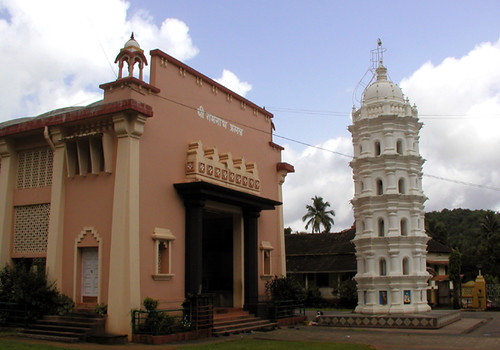
The Ramnathi Devasthan (place of God, or Temple) in Ponda, Goa is our family's ancestral temple. Millenia ago, groups of Konkani families settled in extended family-based communities in Goa. Each community had their own spirits, which protected them from evil and satisfied their spiritual curiosity. The spirits and associated deities also received gratitude for agricultural and female fertility. With time, these spirits evolved into a full-blown God. Ramnath was the benevolent God of our community. His two spouses (Shanteri & Kamakshi) probably represented the heightened fertility required for survival in those days. And we have our own ferocious spirit – Betal, who is responsible for ‘taking care’ of evil.
When members of the extended family leave the community in search of opportunities, they maintain connections to their family gods, also called the Kuladevata. “Kula” refers to the home-base of the extended family community, where the lineage of the family can be traced back to. Thus the Ramnath deity is our family’s Kuladevata. All members of the original community and their descendants are called Kulavis (core family members). All Konkanis will have a Kuladevata Devasthan and are in turn kulavis of that temple..
When Madhvacharya’s fervor spread through Karnataka in the 12th and 13th century, the Ramnathi Devasthan became incorporated into the Vaishanava tradition and became part of the larger Hindu Dharma. Thus Ramnath Dev became a local incarnate of Vishnu, and his spouses Shanteri & Kamakshi became incarnates of “Lakshmi.”
During the Portugese Inquisition in the 1500’s, all Konkani (and Hindu) temples in Goa were destroyed, and churches built in their place. Many Hindus were forced to convert and many others sacrificed their lives for their faith. Libraries, scriptures and literature were systematically destroyed. Devotees smuggled temple deities to safe haven across the Zuari River in what was then part of Goa ruled by a Muslim Sultan from Bijapur. Many Konkanis escaped with few belongings to start new lives elsewhere. Some migrated north to Maharashtra, and most migrated south and settled along the Karnataka Coast. Konkani communities also settled in Cochin and other parts of Kerala.
Devout Konkanis built small temples in each town they settled and kept their faith alive. With the literature destroyed, a dispersed and migrant community maintained the konkani language as an oral tradition. In the 1700s, the Portuguese ended the Inquisition under threat of the British taking over the colony. A status quo was maintained till 1961 when the Portuguese finally left Goa and it became an Indian state. Konkani is now a recognized distinct language in India.
Konkanis dispersed all over the world, thronged to the remote corners of Goa to pay their respects at their Kuladevata temples. Many maintained in wooden shacks were refurbished. Konkani temples are now thriving complexes, representing a symbol of a resilient people; hard working and god fearing.
Considering the circumstances, Konkani temples rebuilt over the decades are not architectural masterpieces. Further, all modern Konkani temples are not where their original communities grew, but clustered across the Zuari River, within 10 miles of each other.
Under the Portugese rule, devotees visited clandestinely from the surrounding states, often involving day-long walks through forests. Appropriately, Konkani temples provide basic accommodations to their devotees. Today, accommodations have been upgraded, but are still spartan. Devotees can get a very basic room at the temple for between $1-$2 per night. One of Goa’s best kept secrets, I’d say. The temples in Ponda are about an hour from Panji the capital, or from the airport near Madgao.
Every time I visit India, I make a beeline to our kuladevata Ramnathi Devasthan in Goa. It is the tradition at Ramnathi and other Konkani temples, for kulavis to visit the deity as soon as you arrive - even before you wash your feet. We leave our sandals/chappals at the door and with dusty feet rush inside to pay our homage to our father protector, guardian and closest confidante. It is akin to the return of a prodigal son (or daughter) and our father wants to see us ASAP, even before we wash our dusty feet. This first visit is thus called “dhool bhaet” (dusty meeting). Only after we pay our respect to the deity, do we then visit the office, rent a room, freshen up and come back into the temple for a proper service.
Due to the remoteness of the area, there are no restaurants around, but for a small shack serving bananas and cold drinks (see pic of shack in this post). We usually ask and are invited to the priest’s house for a delicious konkani vegetarian meal - served on a banana leaf. Per tradition, we leave a small donation for the priest’s family. Many a times, the temple has open lunches sponsored by devotees.
After spending a few days in the serenity of the temple grounds, I will proceed south to visit our relatives and friends.
After learning the history of the Konkani temples, my visits to our kuladevata have more fervor and passion. A recognition of the sacrifices made by our ancestors, so that we may live with their chosen faith. A re-affirmation of my faith, and importantly ... courage. Never again will our homes and places of worship be ransacked; and we be forced to choose between the sword or the cross.
Never Again!
Side Entrance of the Maha Mandal (Front Hall). The high ceilings keep this area very cool even in the middle of a blistering summer. Meant for sermons, but perfect for naps in the afternoon.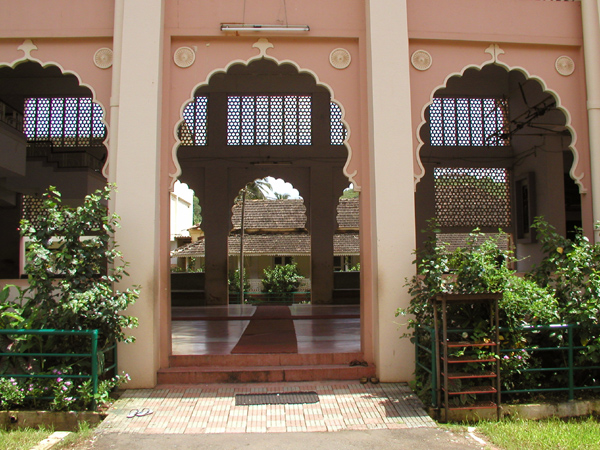
Monday evenings in the front hall, a procession prepares to take the deity Ramnath Dev, for a tour around the temple.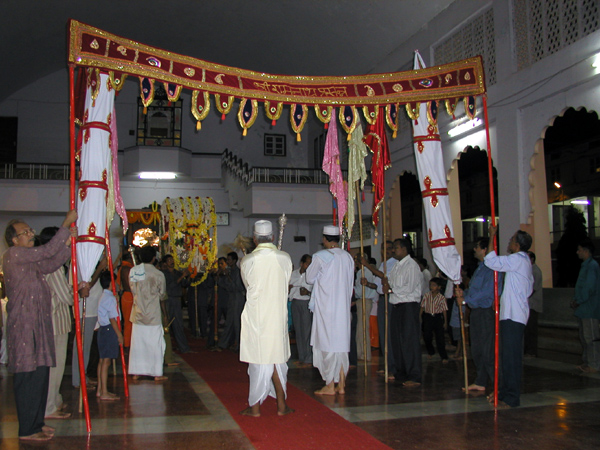
Ramnath Dev sitting in a palki (palanquin) and paraded around the temple complex.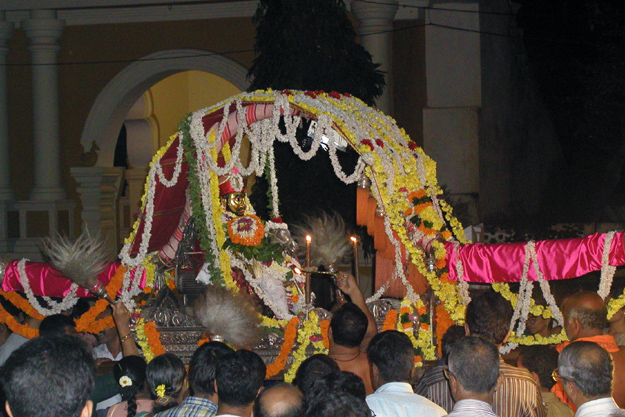
As Ramnath Dev proceeds around the temple, a crowd of devotees follow. The Deep Sthamba is lit at night and it's a beautiful sight. At the conclusion of the procession, an elaborate service is held inside the temple and followed by a sumptuous dinner. Hee Hee! Now you know why I really like to hang out at the temple :-)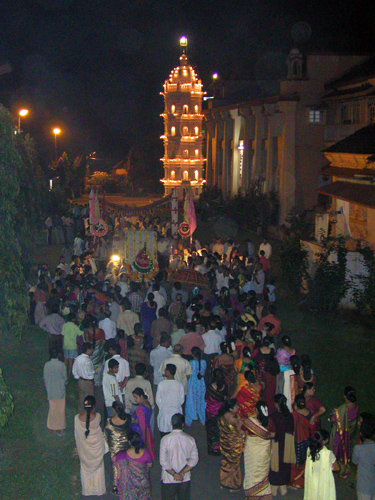
The early morning mist crawls away as a buffalo grazes in the fields across from the Ramnathi Devasthan. Nicely highlights the remote location of the temple.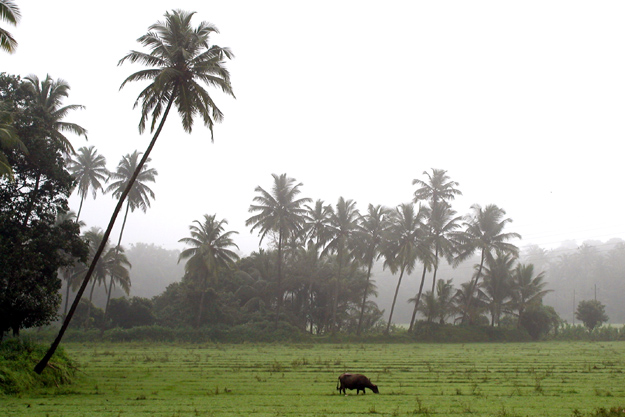
© 2005 Arun Shanbhag
2 comments:
Hi Arun,
Being a konkani myself (chitrapur saraswat) I totally identify with thoughts you have expressed rather beautifully in this post; our saraswat community has suffered a great deal of persecution and sadly even today many amongst us havnt learnt the lessons of understanding, upholding, and promoting our Vedic way of life
Vinay
Arun, the pictures make me nostalgic..we are from Mumbai, and native frm Karkala(Aanu), Mulki(Amma)and Kuladevi - Goa Madkai Navadurga. Hence we used to visit Goa alternate year, during vacations and visit all the temples there which were typically our Konkani temples! The pics reminds me of those same moments as dad used to be equipped wt camera and kids these places were more than happy to pose! Tks for posting with such lovely pics of temples, landscape, the detailed writeup and history!
Post a Comment